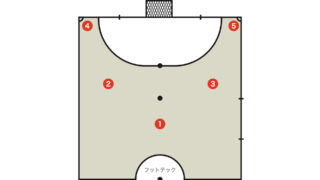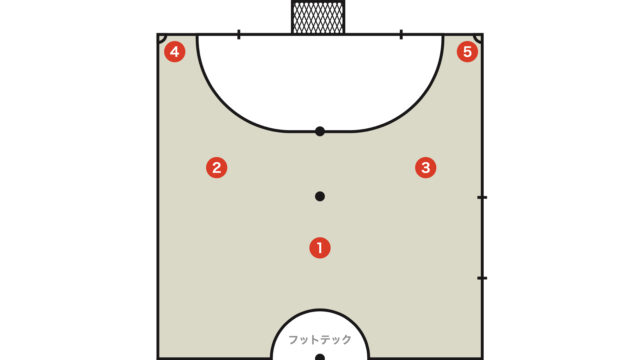For beginners in futsal, the term “special situations” may not be familiar, and it might be unclear what it refers to.
To put it simply, special situations refer to red card ejection scenarios (4vs3) and power plays (5vs4).
Red Card Ejection Scenarios
A red card ejection scenario is, as the name suggests, a situation where a player is sent off following the showing of a red card.
When a Red Card is Shown
In futsal, similar to soccer, a player who is shown a red card is ejected from the match and can no longer participate in the game (including sitting on the bench).
The team with the sent-off player must battle for up to two minutes with only three field players (FPs) and one goalkeeper (GL), making four players in total.
If the opponents score a goal within two minutes or if they successfully defend for two minutes, then the penalized team can add one field player back to the game.
Some people mistakenly believe that if a red card is issued, they must play with one less player for the rest of the match, but this is incorrect.
What Triggers a Red Card?
- Receiving a second caution (yellow card)
- A field player using their hands to stop what would have been a goal
- Intentionally moving the goal to prevent a goal
- Severely unsporting behavior (biting, spitting, violence)
- Making aggressive, insulting, or obscene remarks or gestures
As of the 2020/2021 rule changes, if a field player commits a foul from behind (or the side) in a 1vs1 situation with the goalkeeper, they are now shown a yellow card instead of a red card.
This change is because scoring in a 1vs1 situation with the goalkeeper in futsal is not as easy as in soccer, making it difficult to classify as denying a clear scoring opportunity.
Conversely, fouling an opponent who is about to shoot at an unguarded goal will result in a red card.
How to Utilize the Two Minutes?
While there is a common belief that the right approach is to score quickly in attack and to hold out for two minutes in defense, this is not always the correct answer depending on the score difference and the resources of the players.
If you are winning, it might be effective to deliberately keep possession for the full two minutes and then score towards the end of the period, thereby advancing the game clock.
On the flip side, if you are losing, rather than desperately defending without conceding for two minutes, it might be better to allow an easy goal and get an extra player back to attempt a comeback with the remaining time.
It is important to take a strategic approach as a team with a shared understanding of the situation.

Power Plays (PP)
What is a Power Play?
Unlike soccer, where a power play might involve positioning players strong in aerial duels, such as defenders, as forwards and utilizing long balls, a power play in futsal is a tactic where the goalkeeper joins the attack, resulting in a five-player offensive.
Power (P) and Play (P) are abbreviated as PP.
A technically skilled goalkeeper might join the attack directly, but more often a field player wears the goalkeeper’s jersey and only substitutes for the goalkeeper during the attack.
While it allows for a numerical advantage of 5vs4, there is also the risk of conceding a goal from a power play counter if the ball is lost, since the goal will be unattended.
When to Use Power Plays
Under what circumstances should a power play be employed? The following eight situations are commonly cited:
- When losing
- When wanting to disrupt the opponent’s rhythm
- When the foul count reaches five
- When the goalkeeper has excellent foot skills
- When the opponent has been sent off
- When there is no goalkeeper
- When the team has few members
- When wanting to consume game time
When Losing
This is the most common situation for implementing a power play. In the F-League, teams that are behind often resort to power plays in the final stages of the game.
Power plays often occur in desperate situations towards the end of the game, making them very exciting and a true highlight of futsal.
When Wanting to Disrupt the Opponent’s Rhythm
While power plays are typically used as an option to aim for goals when behind, they can also be used when winning to increase ball possession or to disrupt the opponent’s rhythm.
It can be particularly effective against amateur teams that are not used to defending against power plays.
When the Foul Count Reaches Five
When the foul count reaches five, and the next foul will result in a second penalty kick, teams may use power plays to reduce the risk of committing fouls.
When the Goalkeeper Has Excellent Foot Skills
If the goalkeeper is skilled with their feet, they can join the power play without needing a player substitution.
A trend in the global game is the pseudo power play where the goalkeeper, taking advantage of a kick-in from their own half, switches sides with a wide player and then dribbles forward to finish the move.
When the Opponent Has Been Sent Off
In situations where a red card has been shown and the opposing team is down to one player, it creates a 4vs3 numerical advantage. However, if a goal isn’t scored within two minutes, the opposing team will be back to four players, so teams might start a power play early to aim for a 5vs3 goal.
When There Is No Goalkeeper
For amateur teams, it is not uncommon for the goalkeeper to be absent due to injury or other commitments.
In such cases, a field player has to take on the role of goalkeeper, and by consistently using power plays, the team can maintain a higher possession rate and reduce the chances of conceding shots on goal.
When the Team Has Few Members
As another reason, if there are only about five players available on match day with hardly any substitutes, employing power plays might be more advantageous in terms of conserving energy.
By maintaining possession, there’s no need to defend, and compared to positional attacks, there are fewer positional movements required, allowing the match to proceed with less mobility.
When Wanting to Consume Game Time
The defense against power plays typically involves setting a press line and not pressing beyond it, which makes it effective for time-wasting by circulating the ball in the back.
This is particularly effective when there is little time left in either the first or second half and can be used effectively to close out the game.

Why Are They Called Special Situations?
The conclusion is, quite literally, because they are special situations.
They are special in the following two ways:
- Numerical imbalances (numerical advantage or disadvantage)
- Less mobility (movement)
Particularly, the reduced mobility is a key point, distinguishing these situations from transitions, which also involve numerical imbalances.
Because of these factors, the essence of both offense and defense in these situations is almost identical.
Therefore, it is preferable to consider these two situations (red card ejections and power plays) together as a set.
- Primarily aim for the goal
- Seek to make skip passes
- Delay the rotation of the defense
- Primarily protect the goal
- Intercept skip passes
- Keep the defense compact and rotating
The general idea is to prepare various means (tactics) to achieve these objectives.
Conclusion
In recent years, more teams have been utilizing power plays not only when behind at the end of a game but also in other situations, indicating a shift in the way power plays are perceived.
While it can be daunting to introduce power plays into team strategy due to the risk of leaving the goal empty, it’s recommended to start practicing them gradually instead of dismissing them outright.
- Special situations refer to red card ejection scenarios and power plays
- In ejection scenarios, if a goal is scored or the team defends for two minutes, they can return one player
- There are situations other than when losing where power plays should be used
- Special situations involve numerical advantage and less mobility, with the essence of attack and defense being the same
Thank you very much for reading this article to the end.
If you found this article useful, please consider sharing it using the social media share buttons above.
We regularly share valuable insights on futsal tactics on Twitter, so if you haven’t followed us yet, we’d appreciate your support!
We are committed to raising the level of futsal in Japan by sharing high-quality information through discussions with individuals who have coaching experience in the F.League and overseas.
If you have any questions or notice any mistakes, feel free to leave a comment below.
We update our articles regularly, so if you’d like to keep reading, please bookmark our site or search for “FutTech”!

